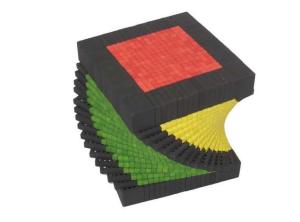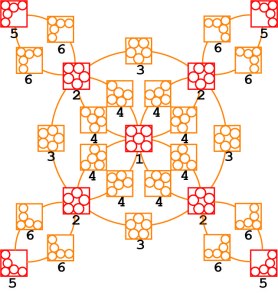It is a celebrated result of John Dixon, (The probability of generating the symmetric group, (subscription) Math. Z. 110 (1969), 199–205.) that if one choose two random permutations in the symmetric group  , uniformly (i.e. each with probability
, uniformly (i.e. each with probability  ), and independently, the probability that the two permutations generate the whole group tends to
), and independently, the probability that the two permutations generate the whole group tends to  as
as  . It is clear that this probability will never be greater than
. It is clear that this probability will never be greater than  , since there is a
, since there is a  probability that the two permutations will both be even, in which case you could only generate, at most, the alternating group. Interestingly enough, Dixon’s paper covers this possibility, and he actually shows that the probability that two permutations generate the alternating group tends to
probability that the two permutations will both be even, in which case you could only generate, at most, the alternating group. Interestingly enough, Dixon’s paper covers this possibility, and he actually shows that the probability that two permutations generate the alternating group tends to  as
as  .
.
Equivalently, if two random elements  of the alternating group
of the alternating group  are chosen uniformly and randomly, the probability that they generate the group tends to
are chosen uniformly and randomly, the probability that they generate the group tends to  as
as  . This leads me to my question — what is the probability that the
. This leads me to my question — what is the probability that the  -regular Cayley graph with generators
-regular Cayley graph with generators  is not Hamiltonian, as
is not Hamiltonian, as  ?
?
Showing that this probability is bounded away from  would provide a counterexample for a notorious problem about vertex-transitive graphs. So we might expect that this is hard. But is it even possible that it is true, or is there some obvious reason that such graphs will tend to be Hamiltonian?
would provide a counterexample for a notorious problem about vertex-transitive graphs. So we might expect that this is hard. But is it even possible that it is true, or is there some obvious reason that such graphs will tend to be Hamiltonian?
Another approach in the same spirit would be computational rather than asymptotic. Suppose we look at thousands of random Cayley graphs on the alternating groups  and
and  , for example. It is straightforward to check that they are connected. Is it within reach for a cleverly designed algorithm on modern computers to conclusively rule out Hamiltonicity for a
, for example. It is straightforward to check that they are connected. Is it within reach for a cleverly designed algorithm on modern computers to conclusively rule out Hamiltonicity for a  -regular graph on
-regular graph on  or
or  vertices? I would also be happy with a computer-aided proof that the conjecture is false.
vertices? I would also be happy with a computer-aided proof that the conjecture is false.
Historical note: It is called the Lovász conjecture, even though he just asked the question (and perhaps conjectured the other way). I am under the impression that some prominent people in this field have felt that the answer should be no. In particular Babai does not believe it.
Rubik’s Cube by Oskar van Deventer and my brain exploded a little bit.
cube), but I like Topsy Turvy as mathematical art, and especially as a “faithful embedding” of the Mathieu group M12 in physical space.



